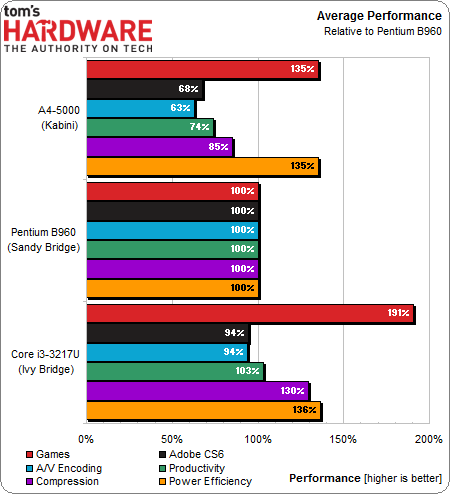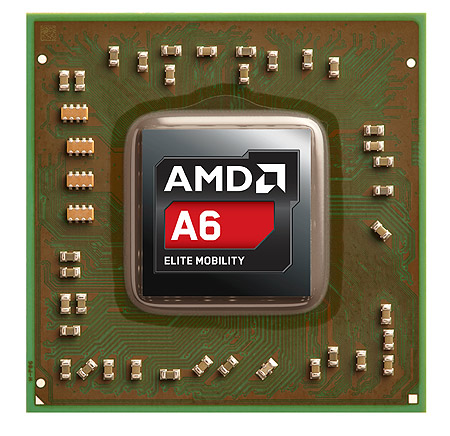AMD's Kabini: Jaguar And GCN Come Together In A 15 W APU
AMD is ready to talk about the Temash and Kabini APUs, based on its Jaguar x86 architecture and Graphics Core Next design. We even have a reference Temash-based notebook here in the lab for benchmarking. How does it compare to Pentium and Core i3?
The Kabini-Based A4-5000: Mediocre Performance, But Great Efficiency
Before we try to reach any conclusions, check out the following chart summarizing performance in each of our benchmarks. Pay particular attention to those orange bars, which represent power efficiency. This is the relationship between each platform's power draw and average performance.
On one hand, the Kabini-based A4-5000 doesn't fare very well when it comes to charting frame rates in games and the time it takes to complete our wide range of desktop workloads. It gets beaten by the dual-core Pentium B960 in every discipline except gaming. But the efficiency bar tells a very different story. Even if you can get Pentium B960-based notebooks fairly inexpensively, you certainly cannot expect them to deliver great battery life with that 35 W processor in there.
So what about the Core i3-3217U, a 17 W processor? Surely that one is a more virile competitor, and not much more expensive than the Pentium. Core i3's on-die HD Graphics 4000 engine with its 16 EUs stomps all over the A4's 128 ALUs, despite the backing of AMD's capable Graphics Core Next architecture. Now, AMD claims that Kabini isn't meant to go up against Core i3. But we found notebooks with this exact CPU selling for as little as $360 on Newegg. It may turn out that the free market doesn't let AMD choose which Intel-based platforms its Kabini-based APUs contend with.
Fortunately, the A4-5000 roughly matched the Core i3-3217U's efficiency. More than likely the A4 is going to give you slightly better battery life at the expense of performance. The bad news for AMD is that 17 W CPUs from Intel already pin Kabini into the budget notebook space, and that's before an onslaught of Haswell-based parts from the top and Silvermont-based options down below.
Truth be told, though Kabini isn't the solution that has us most interested. Sure, it's great to see some compelling hardware from AMD up into the 25 W range. However, we really want to get our hands on Temash. AMD needs to work with OEMs to enable compelling form factors that change the way we work. We have several Atom Z2760-based tablets in the lab. It's great to have x86 compatibility on a handheld device with a full copy of Windows 8, but the build quality of those things frankly sucks. We're talking bending, flexing, intermittent dock connections, and cheap plastic. That's no way to tackle the tablet space. Oh, and we'd really like the flexibility to play something other than Angry Birds, too (though, based on the lackluster gaming numbers in the 15 W range, consider our expectations tempered down at 8 W).
At the end of the day, AMD's next-gen APUs likely have the best chance of success in well-built Windows 8 tablets at the right price. Given a choice between something running Android, an iPad with iOS, or a Surface with Windows RT, the hamstrung Microsoft option seems to get beat up on pretty savagely. But show me an unconstrained Windows 8 device for $100 more and I'll pull my wallet out for you. It's really a shame that AMD talked up what it has planned in this quickly-maturing space and then sent over a notebook that was outgunned in a segment Intel already has saturated with options.
Lastly, it's a bit of a bummer that neither Temash nor Kabini incorporate AMD's heterogeneous unified memory access (hUMA). This is the feature that will allow the GPU and CPU to share system memory without copying it back and forth, eliminating a massive source of latency in today's APUs. This is where we expect the company's SoCs to stand apart from some of the other highly-integrated processors being designed. Unfortunately, we won't see hUMA in a shipping APU until Kaveri is released later this year.
Get Tom's Hardware's best news and in-depth reviews, straight to your inbox.
Current page: The Kabini-Based A4-5000: Mediocre Performance, But Great Efficiency
Prev Page Power ConsumptionDon Woligroski was a former senior hardware editor for Tom's Hardware. He has covered a wide range of PC hardware topics, including CPUs, GPUs, system building, and emerging technologies.
-
zeek the geek This is was we expect on the new consoles, I sure as heck can't wait to see what improvements we'll have on games ported over to PC are. I'm tired of these makeshift ports... Glad to see AMD has their hands in the console field, now maybe we'll see a huge influx of cash on their end to help improve their line and drivers that will give Nvidia a good run for so we can see "OUR money" go to good use. To better technology and innovation!Reply -
slomo4sho With Haswell around the corner claiming models with TDP of 15, 13.5, and 10 watts, the lack of performance in this chipset is discouraging to say the least.Reply -
dragonsqrrl This is the best CPU architecture to come out of AMD in a very long time. It has so many things going for it in comparison to the current competition from Atom. Far superior overall performance, improved power consumption and FP performance over its predecessor (weak points of Brazos), much better graphics performance, broader x86 instruction support, and an actual process advantage (28nm vs 32nm). AMD has a huge opportunity here, and I sure hope they capitalize on it quickly because it won't last long. Atom's based on Intel's upcoming Silvermont architecture will likely outperform Jaguar and reverse most of the advantages AMD currently has.Reply -
BringMeAnother Its performing well in all the wrong areas. If I'm going to play games, I'd rather play with at least high settings with decent resolution. I'm perfectly willing to give up mobility for a gaming machine.Reply -
mcx2500 Given that the AMD Temash and Kabinis are priced in the range of Atoms, it is illustrative that the Tom's reviewer used two Pentium and i3 CPUs that cost over $130 and $200 respectively.Reply
To see the Intel chips utilizing dramatically more watts than the Kabini brings up issues discovered by other reviewers. Just look at the graph of the i3-3217u rated at "17 watt TDP" playing F1-2012 at what is 100% or nearly 35 watts! This means that AMD Kabini A6-5200 which is being released in June will outperform Intel's $225+ i3-3217u for price-performance per watt, you can be on it.
While running the range of applications, the AMD Kabini remained cool while the Intel chips heat up dramatically. This heat has to be dissipated from the laptop and it takes a toll on both the machine and user.
HP just announced 10 point touchscreen laptops that utilize AMD Jaguar Kabinis for a breakthrough price of $399 and that is just a start of a flood of good old competition (hello AMD Kaveri APU Xmas). -
dragonsqrrl mcx2500To see the Intel chips utilizing dramatically more watts than the Kabini brings up issues discovered by other reviewers. Just look at the graph of the i3-3217u rated at "17 watt TDP" playing F1-2012 at what is 100% or nearly 35 watts!This is because the i3-3217u is not an SOC, it's just an ULV dual core Ivy Bridge. Many of the controllers and other supporting hardware are located off die on the mother board, which increases power consumption over the CPU/GPU's rated 17W TDP.Reply
Kabini will have to compete with Intel's upcoming ULV Haswell, which will go as low as ~10W TDP and will be an SOC. This is why I said in my previous comment that I feel AMD has a rare advantage right now and a narrow window of opportunity to make an impact. Jaguar will overlap Silvermont on the low end of its TDP range, and Haswell on its upper end. Both will likely outperform it in their given segments. -
cleeve mcx2500Given that the AMD Temash and Kabinis are priced in the range of Atoms, it is illustrative that the Tom's reviewer used two Pentium and i3 CPUs that cost over $130 and $200 respectively.Reply
AMD told us the Kabini laptop they gave us would be priced $500 on the market, and that cheaper versions would be as low as $350.
We used the cheapest comparison laptops we could find. The only thing it illustrates is that we were trying to give Kabini the best chance of strutting its stuff.
-
amdfangirl AMD Kabini follows the idea of a tablet - people buy them because they are good enough. That's what is causing the downturn in the PC industry. With the performance advantage over ARM chips and Intel Atom, I really see this as a viable alternative in netbooks and Windows tablets.Reply
AMD Kabini sleekbook. I am just drooling at the idea of that. -
amdfangirl dragonsqrrl Kabini will have to compete with Intel's upcoming ULV Haswell, which will go as low as ~10W TDP and will be an SOCReply
No, Kabini competes in the Intel Atom price range like its predecessor, AMD Brazos.
Sure they compete in a similar TDP range, but you wouldn't expect people to compare the chips that go into $999 ultrabooks with chips that will (ultimately) go into the same form factor as them, but are priced at <$400.
ULV processors from Intel are priced at a premium - because Intel is unchallenged in that space. AMD would be insane to try and price Kabini anywhere near IVB or Haswell ULV parts, because AMD will never win by overpricing their products.
"There's no such thing as a bad product, just a bad price point"
Edit: Not entirely sure why my comment got cut off, but here it is. Please note this comparison was made about the ultraportable area of the market, where the main concerns are weight, screen size and battery life. If we start comparing a CPU designed for primarily 11.6" or 10.1" screens with say 35W CPUs in a 15" form factor, you've lost the whole point of the comparison you're doing ultraportable vs. desktop replacements. Sure, if a manufacturer wants to put Kabini in a 15" form factor then it's fair game, but for the majority of Kabini chips, we'll see them in ultraportables, not desktop replacements. -
ta152h Comparing Kabini with SB/IB is like comparing a four cylinder car with an eight cylinder car. It's plain silly, and kind of obnoxious.Reply
This was a poor review because of the choice made there. I think a lot people were curious about how improved it was over the Bobcat. No data. How about the Atom? No data. Let's just compare it with chips the Piledriver competes with, instead of those it does. It makes no sense.
In case you guys haven't figured it out, Piledriver is the competitor for SB/IB, not Kabini. Two different markets. That you justify this so poorly by saying one particular notebook would cost x amount of dollars, is borderline insane. From one notebook, which are based on things other than the cost of the processor as well, you would assume all will cost the same? Strange.
The comparisons with SB/IB aren't worthless, but they should have been in addition to the processors in their market, and also with AMD's Trinity line. Maybe four or five processors, instead of just two that are addressing a higher performance market, and architecturally quite close.
You lost this one to other sites. Normally, especially when Chris writes them, Tom's ends up having the best information. Not this time. Not even close.

